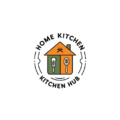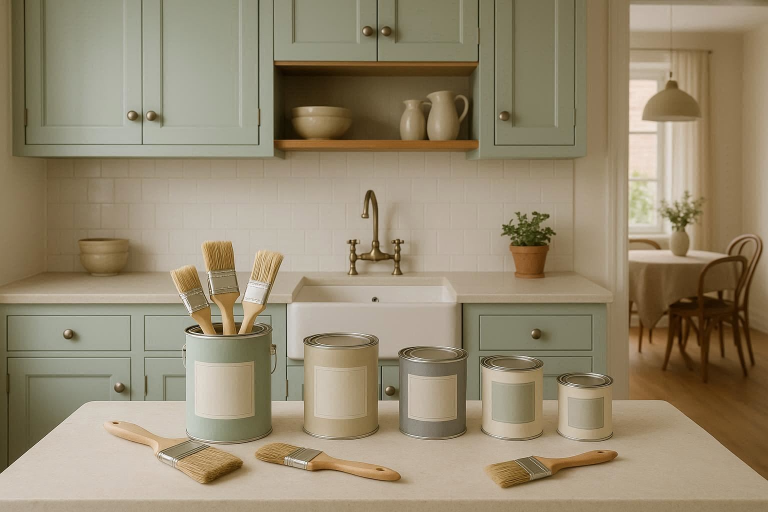Kitchen cabinets play a huge role in the functionality and aesthetics of your kitchen. Whether you’re giving your cabinets a fresh look or preparing for a full renovation, choosing the right paint is crucial. The right paint can not only enhance the beauty of your kitchen but also ensure that your cabinets last longer and stand up to the wear and tear of daily use.
In this blog post, we’ll guide you through the different types of paints recommended for kitchen cabinets, factors to consider when choosing the best paint, and a step-by-step guide on how to paint your cabinets like a pro.
Why Choosing the Right Paint for Kitchen Cabinets is Crucial
Importance of Paint in Cabinet Longevity and Aesthetics
The paint you choose for your kitchen cabinets can dramatically impact both their longevity and appearance. Kitchen cabinets are exposed to heat, moisture, food splatters, and daily wear. A durable, high-quality paint ensures that your cabinets are protected from these elements and that they maintain their visual appeal over time. For cabinets that see a lot of action—such as those near the stove or sink—the right paint can create a long-lasting barrier against stains and scratches.
Additionally, paint gives your kitchen personality. Whether you want a sleek, modern look or a charming, rustic vibe, paint is the easiest and most cost-effective way to update your kitchen.
How the Right Paint Enhances the Kitchen’s Overall Look and Feel
Paint is the simplest way to transform your kitchen. A fresh coat of paint on your cabinets can make the space feel brand new. Whether you’re aiming for a bold, colorful look or a more subtle, neutral tone, the paint sets the tone for the entire kitchen design. The right paint can complement your countertops, backsplash, and flooring, creating a cohesive and inviting space.
Types of Paint Recommended for Kitchen Cabinets
Oil-Based Paints
Durability and Smooth Finish
Oil-based paints are known for their excellent durability and smooth, glass-like finish. They are ideal for cabinets in high-traffic areas since they resist chipping and wear. Oil-based paints take Ideas for Kitchen and Living Room longer to dry, but once cured, they provide a hard, long-lasting finish that can withstand the abuse of kitchen use.
Ideal Use for Cabinets That Endure Heavy Wear
If your kitchen gets a lot of use—especially around the stove, sink, or food prep areas—oil-based paint is a great choice. It’s resistant to moisture, making it an ideal option for kitchen environments.
Pros and Cons of Oil-Based Paint for Kitchen Cabinets
Pros:
- Extremely durable and resistant to wear and tear
- Smooth, even finish that enhances the beauty of wood grain
- Less prone to showing imperfections
Cons:
- Long drying time (24 hours between coats)
- Strong odor due to higher VOC content
- Requires solvents (like mineral spirits) for cleanup
Latex (Water-Based) Paints
Quick-Drying and Easy to Clean
Latex paints are a popular choice for kitchen cabinets because they are easy to apply, quick-drying, and require minimal cleanup. Unlike oil-based paints, latex paints dry faster, allowing you to complete the job in less time.
Benefits of Low Odor and Minimal VOCs
Latex paints emit less odor and have lower volatile organic compounds (VOCs), making them a healthier choice for indoor spaces. This is especially important if you are painting inside your home and want to minimize exposure to harsh chemicals.
When to Choose Latex Paint Over Oil-Based
Latex paint is a better option if you need to complete the job quickly and with less mess. It’s also a great choice if you’re looking for a low-maintenance, easy-to-clean surface.
Chalk Paint
How Chalk Paint Gives a Vintage or Distressed Look
Chalk paint is ideal for creating a shabby chic or vintage aesthetic. It gives cabinets a matte, textured finish that looks worn and distressed. If you want to add character to your kitchen cabinets, chalk paint is a fantastic option.
Easy to Apply with No Priming Required
One of the major advantages of chalk paint is that it requires little to no prep work. You can often skip priming and sanding, which saves you time. Apply the paint directly to the surface, and you’re ready to go!
Best for Cabinets That Need a Unique, Matte Finish
Chalk paint is best suited for those who want a unique, rustic, or farmhouse-style kitchen. If you love the distressed look, this paint is perfect for transforming your kitchen cabinets.
Semi-Gloss vs. High-Gloss Paint
Differences in Sheen and Their Effect on Cabinet Appearance
The finish of your paint can drastically change the look of your cabinets. Semi-gloss paints offer a subtle shine, providing a smooth finish that’s easy to clean but not too reflective. High-gloss paint, on the other hand, gives your cabinets a mirror-like shine. It’s extremely durable and perfect for high-use areas but can highlight imperfections in the cabinet surface.
When to Use Semi-Gloss vs. High-Gloss Finish
If you’re looking for a balance between durability and aesthetics, semi-gloss is the most common choice for kitchen cabinets. High-gloss is ideal if you’re looking for an ultra-modern, sleek look, but keep in mind that it requires a perfectly smooth surface for the best results.
Factors to Consider When Choosing Paint for Kitchen Cabinets
Cabinet Material
The material of your kitchen cabinets plays a major role in determining which type of paint is best.
- Wood Cabinets: Wood is the most versatile material and works well with both oil-based and latex paints. Wood also benefits from the depth and richness that oil-based paints provide.
- MDF (Medium Density Fiberboard) Cabinets: MDF absorbs paint differently, so a good primer is required before painting. Latex paints work best here.
- Laminate Cabinets: Laminate cabinets require a bit more prep work. You’ll need to sand and prime them properly before painting, and oil-based paints tend to work better than latex for a smooth finish.
Kitchen Style and Color Scheme
When choosing paint, think about your kitchen’s style and color scheme. Modern kitchens often look great with clean, crisp whites or neutral tones, while a rustic kitchen might benefit from warmer tones or distressed finishes. The key is to match the paint with the overall theme of your kitchen to create a cohesive design.
Durability and Maintenance
Since the kitchen is one of the busiest areas in the home, it’s important to choose a paint that can withstand wear and tear. Look for paints that are durable, easy to clean, and resistant to stains and moisture.
Step-by-Step Guide to Painting Kitchen Cabinets
Step 1: Prep the Cabinets for Painting
Before you start painting, it’s important to prepare your cabinets properly. Begin by cleaning them thoroughly to remove grease, dirt, and any food particles. Sanding is also essential to create a smooth surface for paint adhesion.
Step 2: Prime the Cabinets
Priming is crucial for ensuring the paint adheres properly. The type of primer you use will depend on the material of your cabinets. For example, use a bonding primer for laminate and MDF, while a standard wood primer works well for wooden cabinets.
Step 3: Apply the Paint
When applying the paint, use a brush, roller, or spray paint, depending on your preference and the desired finish. Apply the paint in thin, even coats. Be sure to allow the paint to dry completely before applying a second coat. Generally, two to three coats will give you the best coverage.
Step 4: Finish and Cure
Allow the paint to dry for the recommended time. After the final coat, give the paint sufficient time to cure before reattaching hardware and cabinet doors. Curing is important for ensuring the paint reaches its maximum durability.
Common Mistakes to Avoid When Painting Kitchen Cabinets
Skipping the Prep Work
Proper prep work—cleaning, sanding, and priming—is essential for a smooth, durable finish. Skipping this step can result in peeling, streaks, and uneven paint.
Choosing the Wrong Paint Finish
The wrong paint finish can affect both the look and durability of your cabinets. Semi-gloss is usually the best choice for kitchen cabinets, but high-gloss may be better if you want a shiny, modern look.
Overloading with Paint
More paint doesn’t always equal a better finish. Using too many layers can cause drips, uneven surfaces, and a longer drying time. Stick to two to three thin coats for the best results.
Not Using the Right Tools
Using cheap brushes or rollers can leave streaks and brush marks on your cabinets. Invest in quality painting tools to ensure a professional-looking finish.
Recommended Brands of Paint for Kitchen Cabinets
Best Oil-Based Paints for Cabinets
- Benjamin Moore Advance: Known for its smooth finish and durability, it’s a top choice for kitchen cabinets.
- Rust-Oleum Cabinet Transformations: A great option for kitchen makeovers, offering a professional finish.
Best Latex Paints for Cabinets
- Sherwin-Williams ProClassic: Offers excellent coverage, durability, and a smooth, long-lasting finish.
- Behr Premium Plus Ultra: Known for its easy application and excellent adhesion, it is a top pick for cabinets.
Best Chalk Paints for Cabinets
- Annie Sloan Chalk Paint: Ideal for vintage or shabby chic kitchens, offering a matte, textured finish.
- Rust-Oleum Chalked Paint: Great for DIY projects, offering an easy-to-use formula for creating distressed looks.
Frequently
What’s the best paint finish for kitchen cabinets?
Semi-gloss is the best finish for kitchen cabinets. It provides durability and is easy to clean without being too shiny. High-gloss can be used for a sleek, modern look.
Can I use regular paint on kitchen cabinets?
Regular paints may not be durable enough for kitchen cabinets. It’s recommended to use paints specifically designed for cabinets to ensure longevity and smooth application.
Do I need to prime kitchen cabinets before painting?
Yes, priming is essential, especially for surfaces like MDF or laminate. It helps the paint adhere better and ensures a smoother finish.
How do I prevent streaks when painting kitchen cabinets?
To prevent streaks, apply thin coats of paint and allow each layer to dry fully before applying another. Use high-quality brushes or rollers to avoid brush marks.
How long does it take for kitchen cabinet paint to dry?
Drying times vary depending on the type of paint. Oil-based paints may take up to 24 hours between coats, while latex paints dry faster, usually within 1-2 hours.
Final Thoughts on Choosing the Right Paint for Your Kitchen Cabinets
Choosing the right paint for your kitchen cabinets is essential to achieving a beautiful, durable finish. Consider factors like the cabinet material, your kitchen’s style, and the durability you need. Whether you choose oil-based, latex, or chalk paint, following the proper preparation and application steps will ensure your cabinets look stunning for years to come.
Now that you know what paint is best for your kitchen cabinets, it’s time to roll up your sleeves and get started on your cabinet transformation! Share your experiences or ask questions in the comments below—we’d love to hear from you!

